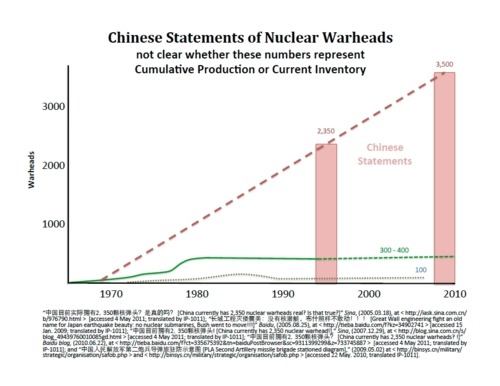My son is a student at our local public high school. As a rule, his teachers do not allow him to use Wikipedia as a source in his research papers because the information it contains can be unreliable. Students are instead expected to find and evaluate the original source material on which the statements contained in Wikipedia entries are based. They are taught that evaluating sources is the essence of competent scholarship.
Unfortunately, the standards for academic integrity appear not to be as high at Georgetown University.
In today’s Washington Post, Georgetown Prof. Philip Karber is praised, by the Post and the Pentagon, for research conducted by his students in a manner my son’s high school teachers would correctly find unacceptable. The Georgetown group collected a small set of internet posts on the size of Chinese nuclear arsenal, which Prof. Karber used to produce the following chart:

At the bottom of the slide is a list of the Chinese “sources” upon which these rather sensational claims are based. All of the sources are individual Chinese blog posts lifted off the internet by Karber’s students. I noticed two problems.
First, the posts themselves do not actually say what is depicted in the slide. They simply ask questions about the rumor they contain about the size of China’s nuclear arsenal, which is based on information contained in a 1995 Usenet post used in a short essay published by a Singapore graduate student in 1996.
Second, that claim that was evaluated and called into question by Jeffrey Lewis back in 2009.
I told the Washington Post reporter that Prof. Karber’s publication of this information in this form was “incompetent and lazy” because neither he, nor his students, bothered to cite either the Singapore graduate student or Dr. Lewis’s critique of his article. Worse still, neither Karber, nor his students, took the time to find and evaluate the original source of this claim, which is an article published in a Hong Kong magazine called “The Trend.” The magazine is clearly identified as the source of the information questioned by the Chinese bloggers in the posts listed at the bottom of Karber’s slide.
In an email responding to criticism of his methods, Prof. Karber justified publishing the slide by saying that the 2350 number was originally reported to have come from a leaked Chinese military document in 1995. He went on to say that the point of highlighting lots of different Chinese sources is to show that this number, and parts of the original document, are widely repeated in China.
This is not competent scholarship. There are thousands of claims on Internet blog posts, supposedly based on US government documents, that aliens from outer space were recovered in Roswell, New Mexico in 1947. Just because a lot of people repeat them in their personal blogs does not give them credibility.
Had he bothered to find the original source Prof. Karber would have found that it is not the contents of the “original document” that is being repeated, but the contents of the Hong Kong magazine article.
Since all these claims stem from a single source, why would serious researchers—if they thought the issue was of high importance—not have tracked down the original source?
I traveled to Hong Kong, found the Hong Kong magazine article and am currently attempting to evaluate the information it contains. It is something my son’s high school teachers would have expected from a researcher, and something Georgetown University, the Pentagon and the editors of the Washington Post should expect too.
